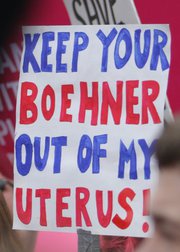
Protest Sign: Keep your Boehner out of my uterus!
The signs are back. Boehner, speaker of the house, wanted to remove federal funding of abortion from the budget as one of the cuts. The thinking goes something like this:
If someone wants to stop spending tax-payer dollars on killing an unborn yet scientifically distinct human life, it’s an invasion of someone else’s rights. They should not only have the right to take this human life, but you should pay for it through your taxes.
Where was the outburst of anger when Obama, Pelosi, and Reid rammed through the Obama health care mandate? This gave more government control over every aspect of health, where was the liberal outcry that government should stay out of our bodies?
Evidently, these protesters want Barack Obama and Nancy Pelosi in their uterus and John Boehner out. They want legislation out of their uterus, but they want government-paid medical equipment in there scrubbing it. The signs seem like it’s a charge against big government intervention but the argument is the opposite. The sign would more accurately read: “Big government needs to be encouraging and funding abortion.” Statistically Planned Parenthood targets the poor, and a higher percentage of minorities are persuaded to abortion than whites. If the goal was to rid America of poor an brown folks, abortion would be the way to go. In fact, that’s why Planned Parenthood was started – to “to create a race of thoroughbreds” by rectifying “the unbalance between the birth rate of the ‘unfit’ and the ‘fit.’” Perhaps the sign should more accurately read:
Big government needs to be encouraging and funding abortion for the lower class and people with brown skin.
I’ve likely severely offended many readers, particularly if they found this article from a web search. Abortion is a highly charged issue for a few reasons:
- For lack of measurable results, the feminist movement pinned their success to the legalization and subsequently federal funding of abortion. The entire feminist push in our culture became focused not on celebrating and valuing what women do, but in promoting abortion because it was a situation unique to women (making it a woman’s issue) and along with more freely available contraceptives, claimed to free up women to have consequence-free sex just like men.
- Abortion is highly personal and highly emotional. Women who find themselves considering the option are in a huge crisis where the options seem like death of the child or suicide of self. If they keep the child their life feels like it will be destroyed, and they may not feel much more hope for the baby. With the political and cultural push for and funding of abortion, it’s not surprising that women make this choice. We’re paying their doctors to do it!
Frederica Mathewes-Green wrote an article about pregnancy centers a few years ago. Most disturbing to me are the statistics that it’s overwhelmingly those with wealth that want funding for Planned Parenthood to be used for providing abortions for poorer Americans. The rich are paying for abortion to be promoted for the poor who don’t want it. Here’s an exerpt:
Those who provide alternatives to abortion believe that pregnancy is just one facet of the woman’s larger and more complex life. They believe she is not best served by treating her as merely a polluted uterus in need of a good scrubbing. Her life is tangled with the life of her child growing within, woven with the lives of the child’s father, with her own parents, friends and co-workers in a tapestry of lives. To remove the child is to cut a hole in the tapestry, by literally cutting into human flesh, tearing the child apart and tearing the mother’s heart. Unplanned pregnancy is not one problem, but a host of problems, great and small; pregnancy care providers try to solve them, one at a time.
Problem pregnancy is associated frequently with poverty, and Planned Parenthood selects the poorer neighborhoods; it is popularly believed that abortion is the best solution for the poor. At any rate, this belief is popular with those who are not poor. Polls regularly show that those with higher income levels are the most likely to endorse public funding of abortion, a gift that the recipients are not eager to accept. David Gergen, in an editorial written before he joined the Clinton administration, pointed out that a 1992 Reader’s Digest poll discovered “poorer Americans are the most opposed to federal funding [for abortion]. Among those earning less than $15,000 per year, opposition ran 63 to 32 percent against funding, while those making over $60,000 favored it by 57 to 41 percent.” Gergen asks, “Is Clinton listening to the people he wants to help?”
When people offer to help you by giving you money to eliminate your children, there’s an implied message that’s hard to miss. A friend who worked in an abortion referral center stocked a flier which explained how we could reduce our tax burden by helping poor women have abortions; one day a Hispanic client came in, slapped the flier on the counter, and hissed, “This is what you really think of us.” Margaret Sanger, the founder of Planned Parenthood, was an enthusiastic eugenicist who wanted “to create a race of thoroughbreds” by rectifying “the unbalance between the birth rate of the ‘unfit’ and the ‘fit.’” Planned Parenthood still has great admiration for Sanger, and president Faye Wattleton said a few years ago that the organization is “just following in the footsteps” of its founder.
Two brands of compassion, each offering what they think is best, but one gets the lion’s share of funding. While pregnancy care centers are a woman-to-woman operation, with funds raised in batches through bake sales and small grants, abortion is more lavishly supported from above. Planned Parenthood Federation of America is the recipient of impressive grants from a long list of foundations and corporations, from Helena Rubenstein to the Pew Charitable Trusts to the New York Times Company. In a typical year, $125 million was received via Government grants and contracts. Planned Parenthood has fought for federal funding of abortion, and with the expanded provisions of the Hyde Amendment will now be able to charge more abortions to the public purse. Some states, as well, use taxpayer funds to underwrite abortions: in Maryland the bill totals $3 million per year. There is plenty of money from above to eliminate the children of the poor, and little need for bake-sale fundraising from below. The director of Planned Parenthood in Maryland is a well-mannered, sober Bostonian in a dark suit; it is hard to imagine him raising funds by poking his head in an office door, like Gloria’s volunteers, and asking how many want a pastrami sub.
